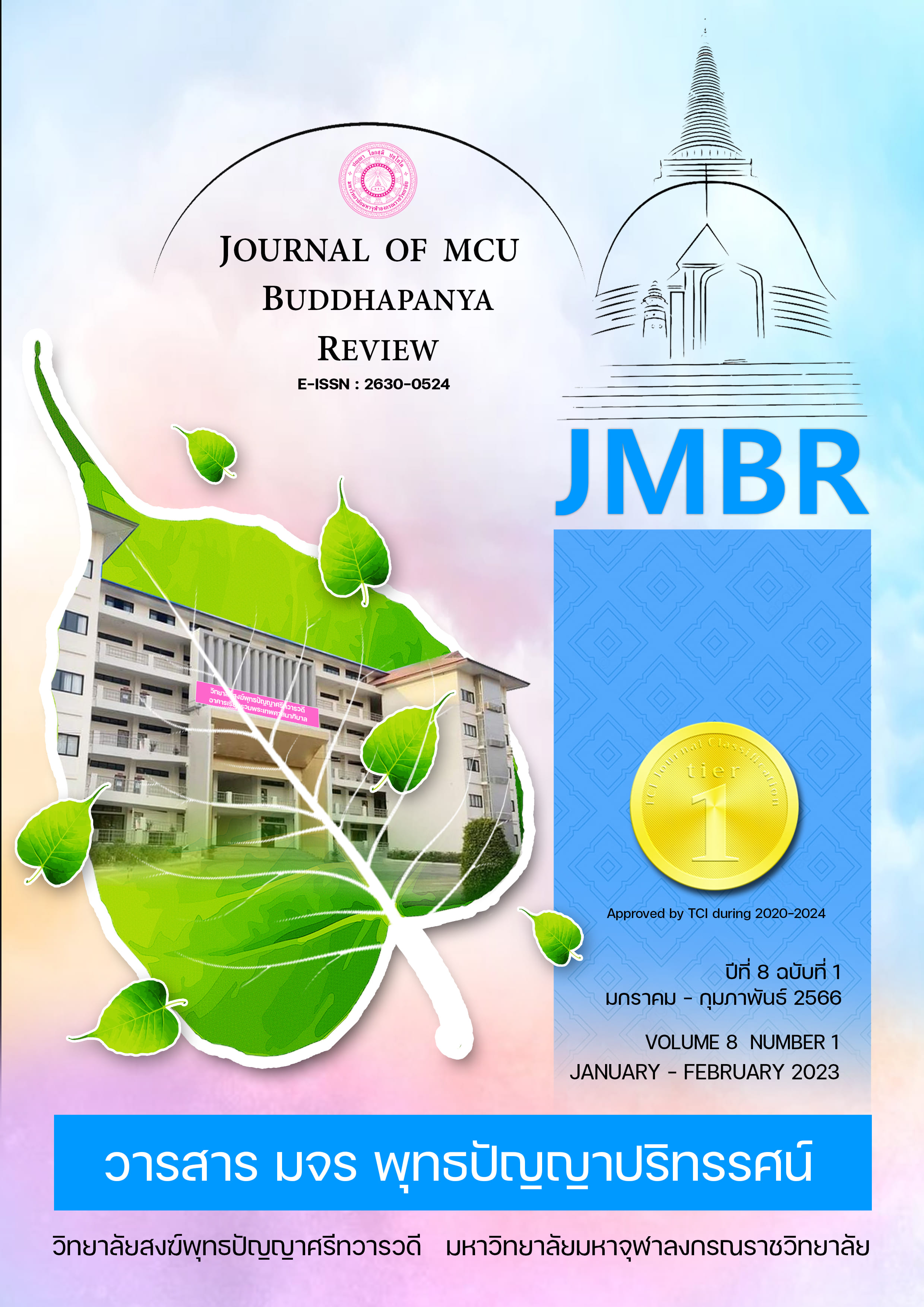พัฒนาการของคำลงท้าย “เล่า” และ “ล่ะ” ในภาษาไทย
คำสำคัญ:
เล่า, ล่ะ, คำลงท้าย, พัฒนาการบทคัดย่อ
งานวิจัยครั้งนี้มีวัตถุประสงค์เพื่อศึกษาพัฒนาการทางหน้าที่และความหมายของคำลงท้าย “เล่า” และ “ล่ะ” ในภาษาไทยตั้งแต่สมัยสุโขทัย - ปัจจุบัน (พ.ศ. 2564) การจัดเก็บข้อมูลแบ่งออกเป็น 3 สมัย ได้แก่ สมัยสุโขทัย สมัยอยุธยา และสมัยรัตนโกสินทร์ สมัยรัตนโกสินทร์ แบ่งออกเป็น 25 ทศวรรษ จำแนกหมวดคำโดยการใช้กรอบประโยคทดสอบ (Phanupong, 1995) และเกณฑ์ทางอรรถศาสตร์
ผลการวิจัยพบว่า “เล่า” เป็นคำเดียวที่เป็นคำเนื้อหา ประเภทคำกริยา สมัยสุโขทัยปรากฏเพียงหน้าที่เดียว คือ คำลงท้าย สมัยอยุธยาและสมัยรัชกาลที่ 1 ถึงรัชกาลที่ 3 มี 3 หน้าที่ ได้แก่ คำกริยา ส่วนมูลฐานในการประสมคำและคำลงท้าย สมัยรัชกาลที่ 4 เป็นต้นไป มี 5 หน้าที่ คือ คำกริยา ส่วนมูลฐานในการประสมคำ วลีตายตัว นามวลีแปลง และคำลงท้าย คำว่า “ล่ะ” ปรากฏครั้งแรกในสมัยรัชกาลที่ 4 - 5 ทำหน้าที่เป็นคำลงท้าย และสมัยรัชกาลที่ 9 - ปัจจุบัน มีหน้าที่เพิ่มอีกประการหนึ่ง คือ วลีตายตัว ในด้านความหมาย คำว่า “เล่า” เป็นเพียงคำเดียวที่มีความหมายประจำ คือ ‘พูด, บอกให้ผู้อื่นฟัง’ ทั้งยังมีความหมายทางไวยากรณ์และวัจนปฏิบัติเช่นเดียวกับคำว่า “ล่ะ” ได้แก่ ความหมายแสดงการบอกเล่า การชี้นำ ความรู้สึก การเกิดซ้ำ ความหมายเหตุผล การเริ่มต้น และการยุติ
เอกสารอ้างอิง
Asoksin, K. (Alias). (1978). Namdokmai. Bangkok: Chokchaithawes.
Aueaphatiphan, S. (Ed.). (2021). Khaosod Online. Retrieved from https://www.khaosod.co.th.
Auppakitsinlapasan, Phya. (2003). Thai Grammar. Bangkok: Thaiwattanapanit.
Caswell, J. and J.H. Chandler. (2001). A dictionary of the Siamese language. Bangkok: Chulalongkorn University.
Damrong Rajanuphap, Prince. (1946). Thiawmueangphama. Bangkok: Fine Arts Department.
_______. (2545). Nithan Boranakadee. Bangkok: Bannakit.
Dokmaisod (Alias). (1998). Nuengnairoi. Bangkok: Bannakit.
Faculty of Arts Chulalongkorn University. (2007). TNC: THAI NATIONAL CORPUS. Retrieved from http://www.arts.chula.ac.th/ling/tnc/.
Fine Arts Department. (2012). Traibhumikatha. Bangkok: Fine Arts Department.
Hopper, P. J., & Traugott, E. C. (2003). Grammaticalization (3rd ed.). Cambridge: Cambridge University Press.
Hornby, A. S. (2015). Oxford Advanced Learner’s Dictionary of current English. (9th ed.). Oxford: Oxford University Press.
Iamsa-ard, A. (2020). A Diachronic Study of the Word /khrâj/. (Master of Arts Thesis), Kasetsart University, Program in Thai.
Intrasut, T (Ed.). (1927). Mahawitthayalai. Bangkok: Chulalongkorn University.
Jaratjarungkiat, S. (2012). The development of the Word /pen/ in Thai. (Doctor of Philosophy Thesis), Chulalongkorn University, Program in Thai.
Jarungkitanan, W. (2008). Maebia. Bangkok: Praew.
Kullavanijaya, P. (2008). a Historical Study of /thii/ in Thai. In A. Diller, J. Edmonson, & Y. Luo (Eds.). The Tai-Kadai Languages (pp. 455-467). New York: Routledge.
Maha Vajirunhis, Prince. (2007). The letter of Prince Maha Vajirunhis. Bangkok: Bannakit.
Matichon. (2017). Silpawattanatham Journal. Retrieved from https://www.silpa-mag.com/.
Naya (Alias). 2004. Ramphoeidoksutthai. Bangkok: Phueandee.
Nichnita (Alias). (2011). Longklinchan. Bangkok: Fin book.
Nitiprapha, V. (2015). Saidueantabotnaikhaowongkot. Matichon.
Panthumetha, N. (2015). Waiyakorn Thai. Bangkok: Faculty of Arts Chulalongkorn University.
Phanupong, W. (1995). The Structure of Thai. Bangkok: Ramkhamhaeng University Press.
Phongsakorn (Alias). (2011). Kiphao. Bangkok: Groove Publishing.
Phraklang (Hon), Duke. (1972). Samkok. Bangkok: Silpabannakan.
______. (2020). Rajathiraj. Nonthaburi: Sripanya.
Prasitrattasinthu, A. (2010). Part of Speech in Thai Language: Syntax Analysis. Bangkok: Chulalongkorn University.
Rangsit, V., H.S.H. (1969). Go to USA B.E. 2503. Bangkok: Phrachan.
Satchasarasin, W. (2012) We forgot something. (13 ed.). Bangkok: Nakorn.
Sriprasit, M. (2003). A diachronic study of /laeaew/, /yuu/ and /yuulaeaew/. (Master of Arts Thesis), Chulalongkorn University, Program in Thai.
Thakoonrachainsingha. (1977). Mahabharatayuth. Bangkok: Klangwittaya.
The Division of Protection of Wisdom of Thai Traditional Medicine and Thai Folk. (2007). The Medicine Treatise of King Rama II. Bangkok: Ministry of Health.
Thepayasuwan, B., M.L. (1977). Chaknuengnaicheewit. Bangkok: Bannakit.
The Royal Institute. (2013). The Royal Institute Dictionary B.E. 2554. Bangkok: Nanmeebooks.
Thomson, L. C. (1965). A Vietnamese Grammar. Seattle: University of Washington Press.
Tsyboi, S. (1992). Yisibsiduangta (K. Amorntat, Trans.). Bangkok: Pradulai.
Varotsikkhadit, U. (1999). Thai Grammar in Linguistics. Bangkok: Ramkhamhaeng University.
Yuttapongtada, M. (2012). Function and Semantic Extension of the Word /tua/ from the Sukhothai Period to B.E. 2551. (Doctor of Philosophy Thesis), Kasetsart University, Program in Thai.
ดาวน์โหลด
เผยแพร่แล้ว
รูปแบบการอ้างอิง
ฉบับ
ประเภทบทความ
สัญญาอนุญาต
ลิขสิทธิ์ (c) 2023 วารสาร มจร พุทธปัญญาปริทรรศน์

อนุญาตภายใต้เงื่อนไข Creative Commons Attribution-NonCommercial-NoDerivatives 4.0 International License.



